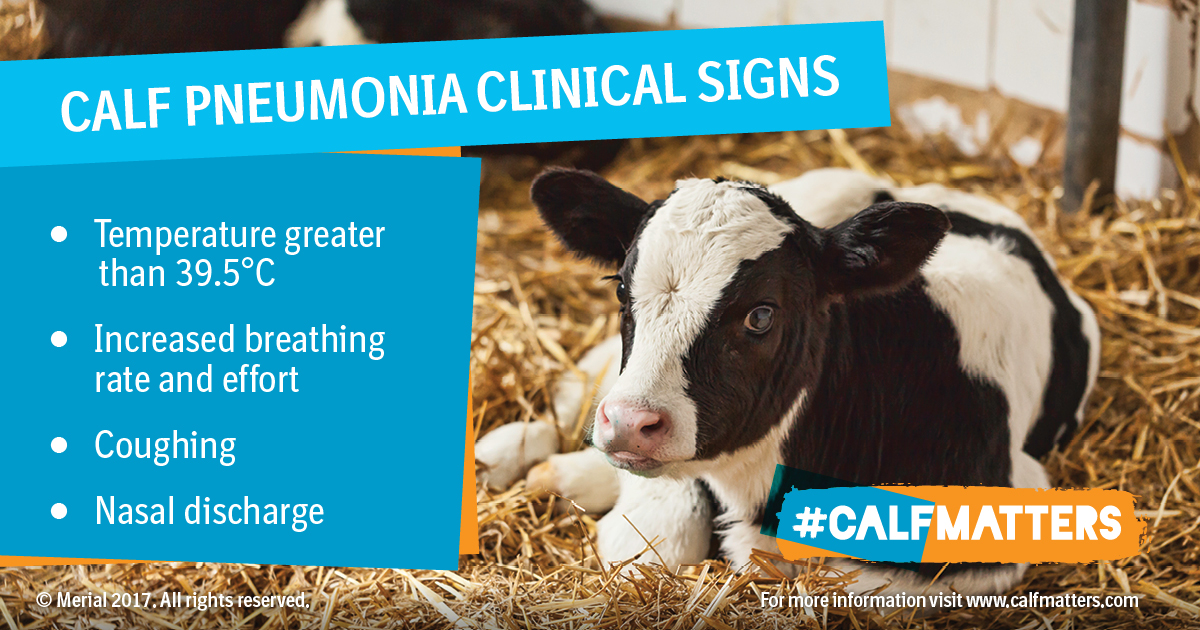What are the causes of calf pneumonia and what to do

In the UK, the cost of infectious respiratory diseases in young calves has been estimated at £60 million a year.1 It is the most common reason for death and poor performance in calves and young, growing cattle.
Calf pneumonia is the result of a complex interaction between viral and bacterial pathogens, environmental stress factors, and the animal’s own resilience to disease.
Calf pneumonia causes inflammation and damage of the lung tissue and airways, compromising lung function. In severe cases the damage is irreversible and can result in death, but even mild cases of pneumonia can significantly increase the cost of production.
Causes of Calf Pneumonia
Calf pneumonia results from a complex interaction between disease-causing viruses and bacteria and the animal’s immune system that is also influenced by external stress factors. The important viral causes of respiratory disease are Bovine Respiratory Syncytial Virus (BRSV), Parainfluenza-3 virus (PI-3) and Bovine Herpes Virus -1 (BHV-1), the cause of Infectious Bovine Rhinotracheitis (IBR). Bovine Viral Diarrhoea (BVD) may also be associated with pneumonia in some herds due to the negative effects it has on an animal’s immune status.
These viruses can cause disease by themselves or damage the defence mechanisms of the respiratory tract and predispose the calf to secondary bacterial infections of the lungs. There are a large number of bacteria that can cause disease in their own right or act as secondary invaders following viral damage to the lung defence mechanisms. The important bacteria associated with calf pneumonia are Mannheimia haemolytica, Pasteurella multocida, Histophilus somni and Mycoplasma bovis.
An animal’s susceptibility to calf pneumonia will be influenced by the strength of its immune system.
In young calves the single biggest factor affecting the immune system is colostrum. Ensuring calves receive good quality colostrum as quickly as possible after birth will give them the best possible start in life and help reduce the risk of disease. A calf’s immunity will also be affected by nutrition, management practices, stress and the environment – with issues in any of these areas having a negative impact on the calf’s ability to fight disease. Mixing animals of different ages or from different sources within the same airspace will increase the risk of respiratory disease. Similarly, if animals are placed in sheds that are poorly ventilated or humid, even high levels of immunity will not prevent disease outbreaks.
How does calf pneumonia affect calves?
Stress, resulting from management practices, suboptimal nutrition and in young calves poor immunity as a result of inadequate colostrum intake, all increase susceptibility to calf pneumonia. Viruses are often the initial invader. They cause lung damage that soon allows secondary bacterial infections to take hold.
Clinical signs of calf pneumonia include:
- A temperature of greater than 39.5o C
- Increased breathing rate and effort
- Coughing
- A nasal discharge which is initially clear and watery but becomes thick and pus-like as the disease progresses
During the early stages of infection calf pneumonia can be difficult to detect. An elevated temperature is the first sign of disease and typically occurs 12-72 hours before detectable clinical signs appear2.

Early Detection
Developing monitoring strategies to identify cases early in the course of disease is critical
Early detection, diagnosis and treatment of calf pneumonia have recognised benefits:3
- Improved response to treatment and quicker resolution of clinical signs
- Reduction in lung damage and the risk of developing chronic disease
- Reduction in re-treatment rates
- Reduction of pathogen spread and new cases of disease
- Reduction in the impact of pneumonia on future growth and productivity
Prevention
Given the multi-factorial nature of the disease, good calf pneumonia control programmes rely on implementing an appropriate vaccine strategy alongside improvements to management practices, to reduce the risk of disease. Vaccines are available that will enhance protection against the common viral, and some of the bacterial causes of calf pneumonia. It is important that vaccines are administered prior to high risk periods to ensure that there is sufficient time for animals to develop effective immunity.
What is #CALFMATTERS?
#CALFMATTERS is an educational program from Boehringer Ingelheim Animal Health promoting best practice in calf rearing to farmers through their vet.
For more information and top tips on vaccination against calf pneumonia read here.
- 1 Welsh Dairy Heifer Report (2015) Hybu Cig Cymru
- 2 Wolfger et al. (2015) A Systematic Review of Bovine Respiratory Disease Diagnosis Focused on Diagnostic Confirmation, Early Detection, and Prediction of Unfavorable Outcomes in Feedlot Cattle. Veterinary Clinics of North America Food Animal 31, 351–365
- 3 McGuirk & Peek (2014) Timely diagnosis of dairy calf respiratory disease using a standardised scoring system. Animal Health Research Reviews 15, 145–147